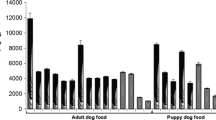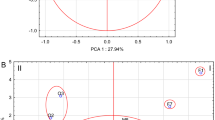Abstract
Brazil holds the second largest population of domestic dogs in the world, with 33 million dogs, only behind the United States. The annual consumption of dog food in the country is 1.75 million tons, corresponding to the World’s sixth in trade turnover. Dog food is supposed to be a complete and balanced diet, formulated with high quality ingredients. All nutrients and minerals required for an adequate nutrition of dogs are added to the formulation to ensure longevity and welfare. In this context, the present study aimed at assessing the chemical composition of dry dog foods commercialized in Brazil. Thirty-four samples were acquired in the local market of Piracicaba and analyzed by instrumental neutron activation analysis (INAA) to determine the elements As, Br, Ca, Co, Cr, Cs, Fe, K, La, Na, Rb, Sb, Sc, Se, U, and Zn. In general, the concentrations of Ca, Fe, K, Na, and Zn complied with the values required by the Association of American Feed Control Officials (AAFCO). To evaluate the safety of dog food commercialized in Brazil, further investigation is necessary to better understand the presence of toxic elements found in this study, i.e. Sb and U. INAA was useful for the screening analysis of different types and brands of dry dog foods for the determination of both essential and toxic elements.

Similar content being viewed by others
References
Romanini C (2010) Veja Mag 43:141–146
AnfalPet (2010) Pet market. http://anfalpet.org.br. Accessed 14 Jul 2010
Alltech (2011) Pet nutrition and health. http://www.alltech.com. Accessed 4 Feb 2011
Thompson A (2008) Top Companion Anim Med 23:127–132
Chandler ML (2008) Top Companion Anim Med 23:148–153
Nunes RV, Rostagno HS, Albino LFT, Gomes PC, Toledo RS (2001) Rev Bras Zootec 30:785–793
Girio TMS (2007) MSc Dissertation, Universidade Estadual Paulista, São Paulo, p 45 (in Portuguese)
Alvarado CA, Hodgkinson SM, Alomar D, Boroschek D (2008) Arq Bras Med Vet Zootec 60:218–226
Neves MCP (2006) Perigos químicos nos alimentos. Embrapa Agrobiologia, Seropédica
Custódio DP, Brandstetter EV, Oliveira IP, Oliveira LC, Santos KJG, Machado OF, Araujo AA (2005) Rev Eletr Facul Montes Belos 1:131–147
Buchanan R (2010) Food safety challenges facing the pet food industry. In: Waltham International Nutritional Sciences Symposium Abstract Book. University of Cambridge, Cambridge
Atkins P, Ernyei L, Driscoll W, Obenauf R, Thomas R (2011) Spectroscopy 26:46–56
Duran A, Tuzen M, Soylak M (2010) Food Chem Toxicol 48:2833–2837
Association of Official Analytical Chemists—AOAC (2002) Official methods of analysis, 18th edn. AOAC, Washington DC
França EJ, De Nadai Fernandes EA, Bacchi MA (2003) J Radioanal Nucl Chem 257:113–115
Bacchi MA, Fernandes EAN, Oliveira H (2003) J Radioanal Nucl Chem 257:577–582
Ministry of Agriculture, Livestock and Food Supply—MAPA (2002) Instruction n° 08. MAPA, Brazil, 11 Oct 2002
Association of American Feed Control Officials—AAFCO (2008) Dog food nutrient profile. AAFCO, Arizona
Feuer D (2006) Your dog’s nutritional needs. National Academy of Sciences, Washington
Peterson J, MacDonell M, Haroun L, Monette F(2007) Radiological and chemical fact sheets to support health risk analyses for contaminated areas. Argonne National Laboratory, Illinois
Schoulten NA, Teixeira AS, Bertechini AG, Freitas RTF, Conte AJ, Silva HO (2002) Ciênc Agrotecnol 26:1313–1321
Dobenecker B, Kienzle E (2010) Breed differences of calcium and phosphorus metabolism in growing dogs. In: Waltham International Nutritional Sciences Symposium Abstract Book. University of Cambridge, Cambridge
Carciofi AC, Vasconcellos RS, Borges NC, Moro JV, Prada F, Fraga VO (2006) Arq Bras Med Vet Zootec 58:421–426
Schmidt-Nielsen K (1997) Animal physiology: adaptation and environment. Cambridge University Press, Cambridge
MacDonald RS (2000) J Nutr 130:1500S–1508S
Jamikorn U, Preedapattarapong T (2008) Thail J Vet Med 38:9–16
Kastenmayer P, Czarnecki-Maulden GL, King W (2002) J Nutr 132:1670S–1672S
Fernandes EAN (1993) J Radioanal Nucl Chem 168:41–46
Yu S, Wedekind KJ, Kirk CA, Nachreiner RF (2006) J Anim Physiol Anim Nutr 90:146–151
Markert B (1998) In: Schüürmann G, Markert B (eds) Ecotoxicology. Wiley, New York
Committee on Minerals, Toxic Substances in Diets, Water for Animals, National Research Council (2005) Mineral tolerance of animals. National Academies Press, Washington
Subcommittee on Dog, Cat Nutrition, Committee on Animal Nutrition, National Research Council (2006) Nutrient requirements of dogs and cats. National Academies Press, Washington
Crispino CC (2007) MSc Dissertation, Universidade Federal de São Carlos, São Carlos, p 95 (in Portuguese)
European Union—EC (2002) Directive 2002/32/EC of the European Parliament and of the Council. European Union, Brussels, 7 May 2002
Atkins P, Ernyei L, Driscoll W, Obenauf R, Thomas R (2011) Spectroscopy 26:42–59
Teruya CM (1999) MSc Dissertation, Universidade de São Paulo, São Paulo, p 90 (in Portuguese)
Smichowski P (2008) Talanta 75:2–14
National System of Sanitary Surveillance (2010) Resolution RDC nº 52. http://www.nbn.gov.au/. Accessed 26 Nov 2010
Batista BL (2009) MSc Dissertation, Universidade de São Paulo, São Paulo, p 77 (in Portuguese)
Avelar AC, Ferreira WM, Menezes MABC (2007) Rev Saude Ambiente 8:37–42
United States Environmental Protection Agency (2010) Understanding radiation in your life, your world. http://www.epa.gov/radiation/radionuclides/uranium.html. Accessed 9 Feb 2011
Acknowledgments
The authors are thankful to The State of São Paulo Research Foundation—FAPESP for financial support (process 10/52425-7).
Author information
Authors and Affiliations
Corresponding author
Rights and permissions
About this article
Cite this article
Elias, C., De Nadai Fernandes, E.A. & Bacchi, M.A. Neutron activation analysis for assessing chemical composition of dry dog foods. J Radioanal Nucl Chem 291, 245–250 (2012). https://doi.org/10.1007/s10967-011-1285-6
Received:
Published:
Issue Date:
DOI: https://doi.org/10.1007/s10967-011-1285-6




